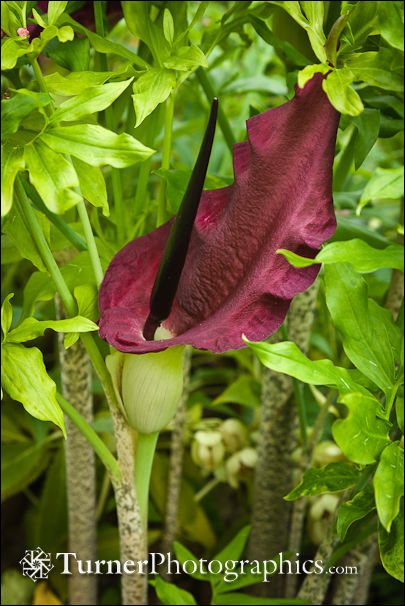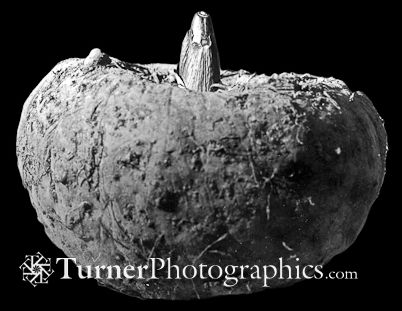Plant of the Month: Voodoo Lily
 Every garden should have at least one plant that makes every visitor stop in their tracks and ask “what’s that?” Maybe its even one your spouse questions why you’d grow it.
Every garden should have at least one plant that makes every visitor stop in their tracks and ask “what’s that?” Maybe its even one your spouse questions why you’d grow it.
In our garden that plant is a Voodoo Lily, also known as Snake Palm, Devil’s Tongue, Black lily of the Nile, and Sacred lily of India. I originally learned it as Stink Lily from my father who grew them in his West Virginia garden. According to a newspaper article from 1971 he got his first corm from my grandmother deGruyter in 1951. I still have the file folder of information he collected on it in the 1950s and 60s. As far as I can determine, the plants I have are Amorphophallus rivieri. There are many species of Amorphophallus, as well as similar plants in Dracunculus, Sarmomatum, and Arum.
All of these members of the Lily family are pollinated by flies. That’s why they smell like rotting meat when in bloom. The odor is quite strong, either sending passers-by scurrying on their way or causing them to stop and try to figure out where it is coming from. Once the flower has been pollinated the odor stops and the flower wilts as seed production begins.
The oversized flowers consist of a large dark reddish-purple spathe surrounding an even darker purple spadix. The ovary is hidden inside the spathe at the base of the spadix.
My dad used to dig the large corms in October and store them in a box of vermiculite in the garage for the winter. In January he’d bring them out and take them to his chemistry classroom where they’d put up a solitary rapidly-growing flower stalk that could be more than six feet tall. He charted the growth daily. Someplace there are family pictures of the flowers towering over me as a first grader. The corm for that flower was huge, weighing about 18 pounds.
 Once the flowering was finished my dad would plant the corms back in the garden, where they’d put up foliage and replenish their strength during the summer. I don’t remember them blooming in the summer in his garden. I also didn’t think they were hardy. However, after he died in 1978 they continued to grow unattended for about 25 years. I dug up some corms in 2001 and brought them to my Bellingham garden where I put them in a nurse bed. About three years ago I dug them and planted a few in my front garden where they’re now blooming. I also shared corms with friends in the Birchwood Garden Club. The corm shown here was photographed in early 1970 and is a parent of the flower in my 2010 garden at the top of the post.
Once the flowering was finished my dad would plant the corms back in the garden, where they’d put up foliage and replenish their strength during the summer. I don’t remember them blooming in the summer in his garden. I also didn’t think they were hardy. However, after he died in 1978 they continued to grow unattended for about 25 years. I dug up some corms in 2001 and brought them to my Bellingham garden where I put them in a nurse bed. About three years ago I dug them and planted a few in my front garden where they’re now blooming. I also shared corms with friends in the Birchwood Garden Club. The corm shown here was photographed in early 1970 and is a parent of the flower in my 2010 garden at the top of the post.
The corms I have are much smaller than the ones my dad grew, but perhaps with time and a little more attention I’ll have a couple of monsters, too. My mother thought they were fascinating, but wouldn’t allow them in the house, which is why they went to my dad’s classroom. My wife isn’t all that excited about them either, but as long as they stay in the garden she appreciates this dramatic oddity.


Thanks Mark!
I really enjoyed the history of your family’s corms. I think that personal histories are what make good writing as they bring the information down to a more intimate nature.
I’ll try out some of your ideas for a more steady camera. Wish I had had them about a month a go when we were in Montana and watched, fascinated, a grizly bear walk across a mountain meadow across the river and about a third of a mile away. I zoomed and took three pictures before my batteries went dead, but the best of them are somewhat fuzzy. If another chance of a lifetime comes along, I’ll know what to do!